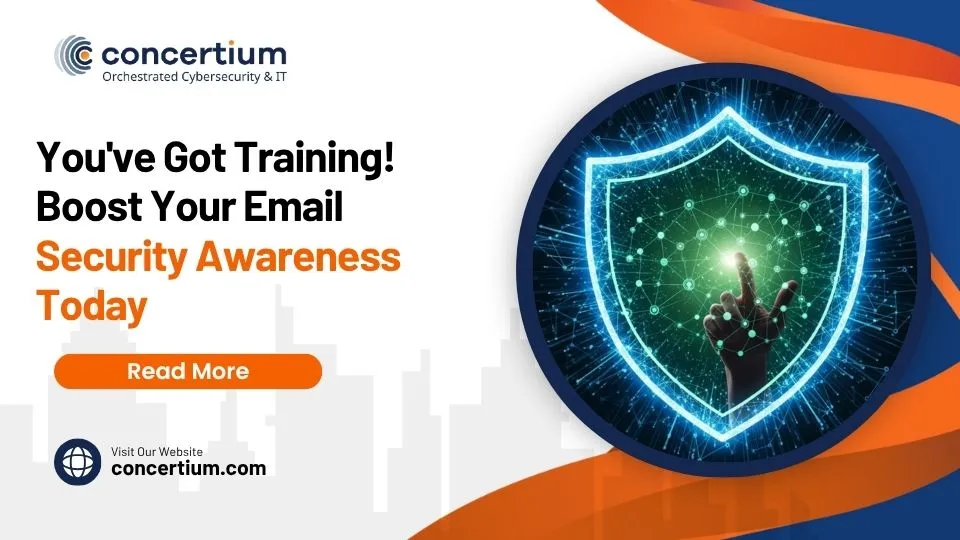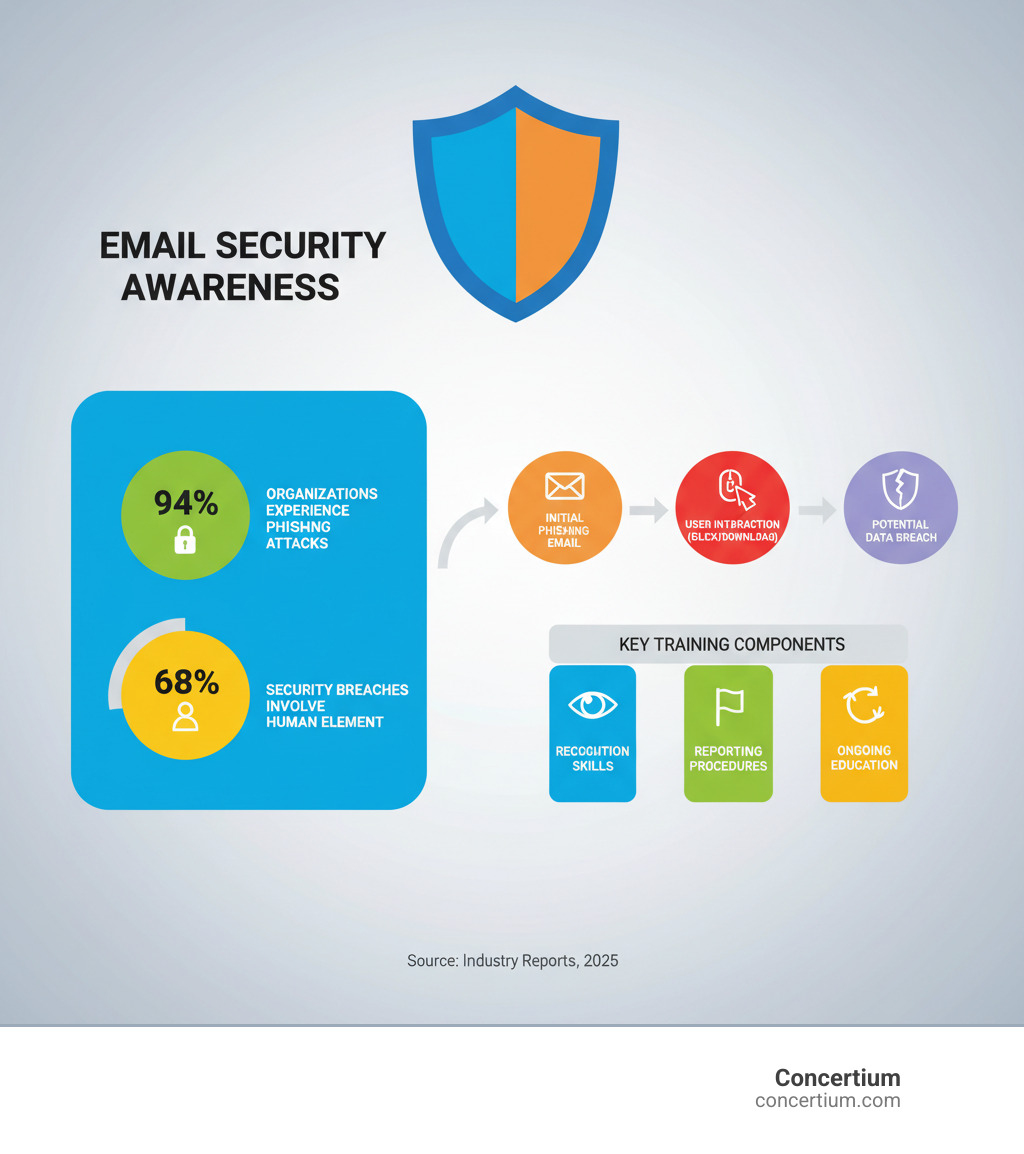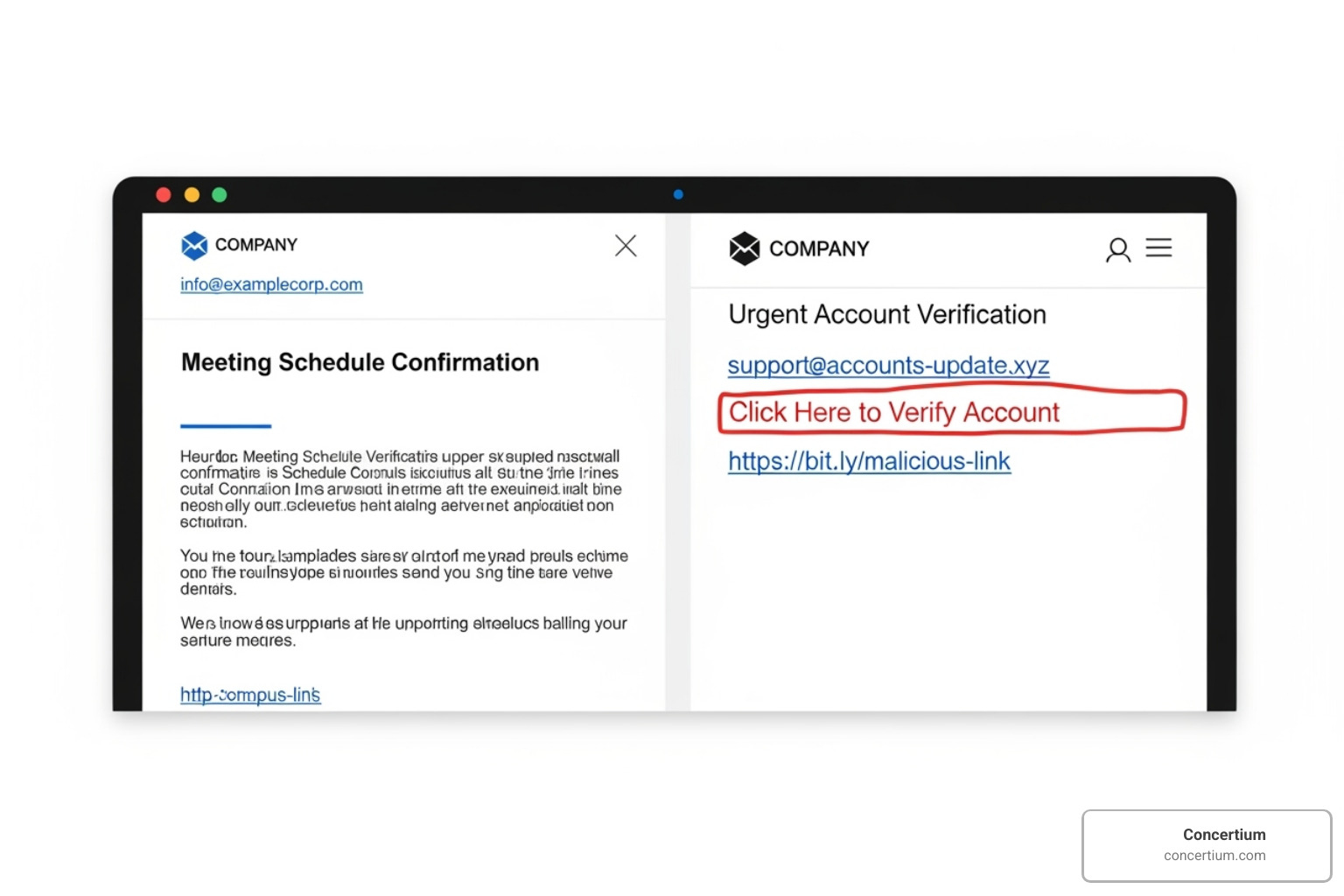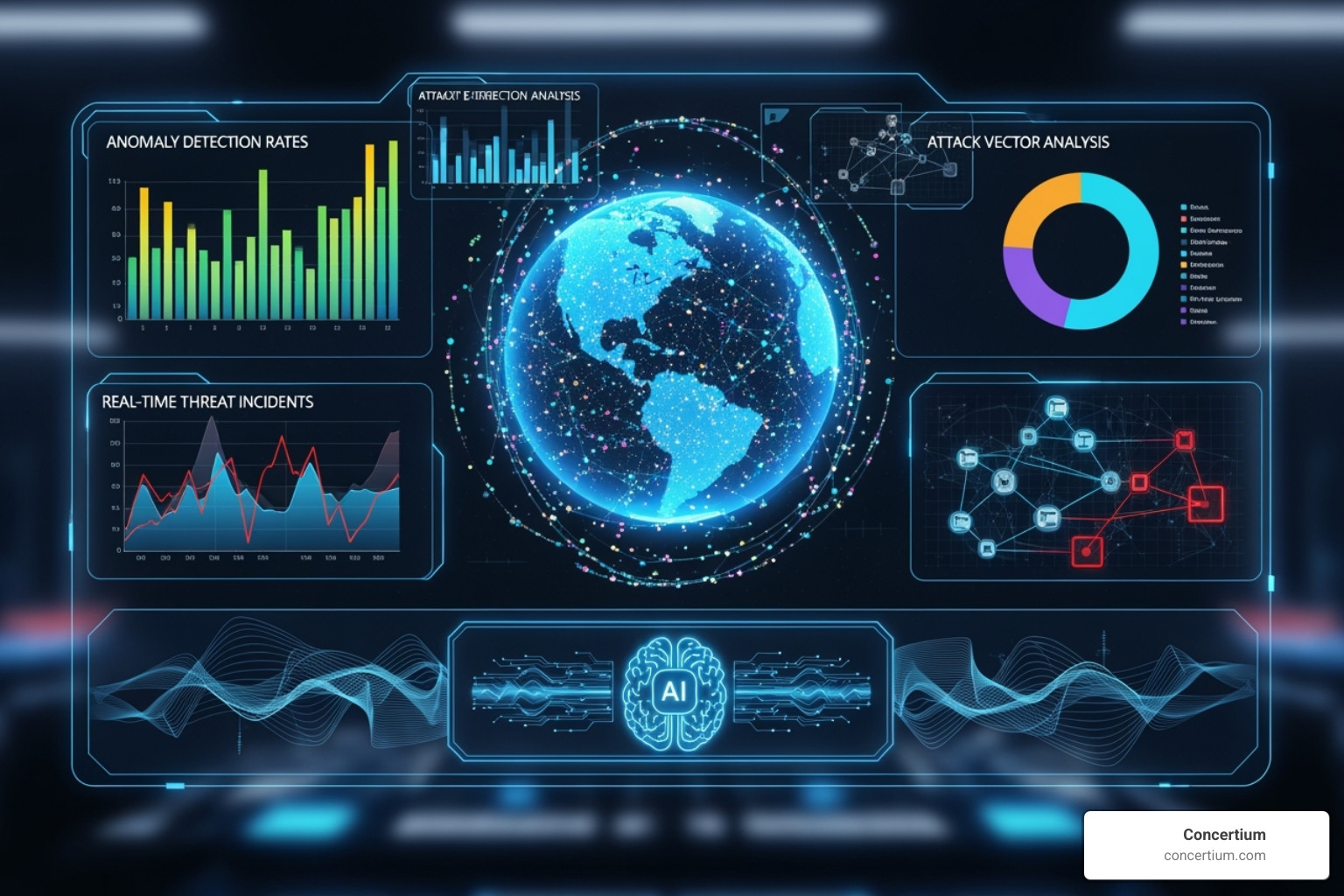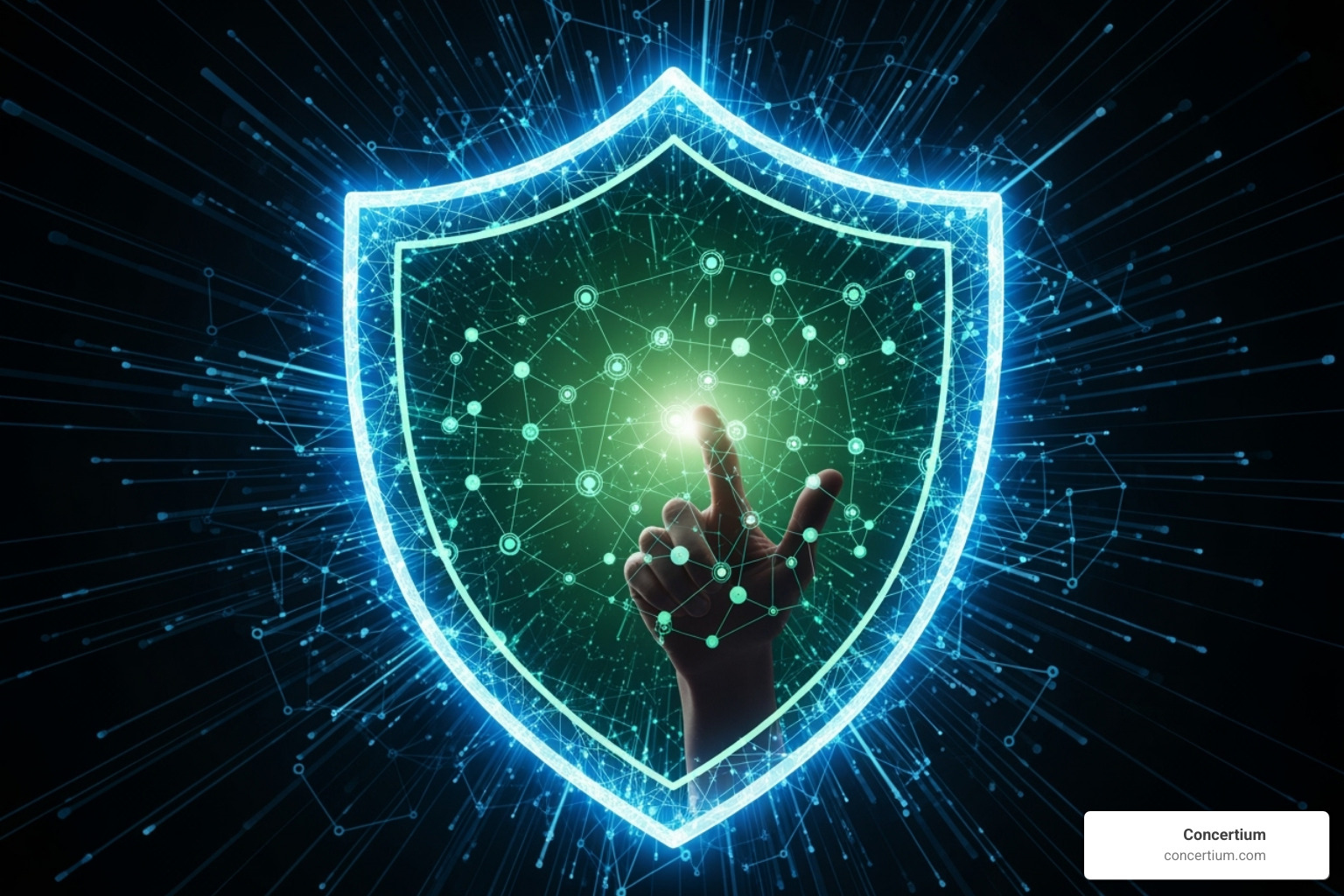AI Overview:
Email Security Awareness is the frontline defense against today’s cyber threats—teaching employees how to recognize, avoid, and report phishing, malware, and social engineering attacks. With over 90% of breaches starting from email, awareness isn’t optional—it’s critical.
Why Email Security Awareness Matters More Than Ever
Meta Title: You’ve Got Training! Boost Your Email Security Awareness Today
Meta Description: Find why email security awareness is crucial for your organization. Learn to identify common email threats, build effective training programs, and leverage AI to protect your business from phishing and cyberattacks.
You’ve Got Training! Boost Your Email Security Awareness Today
Email security awareness is the knowledge and skills employees need to identify, avoid, and report email-based cyber threats like phishing, malware, and social engineering attacks. Here’s what you need to know:
Key Components of Email Security Awareness:
- Recognition skills – Spotting suspicious emails, links, and attachments
- Reporting procedures – Knowing how and when to alert IT teams
- Safe practices – Verifying requests, avoiding risky actions
- Ongoing training – Regular updates on evolving threats
The numbers tell a sobering story. Over 90% of cyber-attacks start with a phishing attempt, and even after training, 23% of phishing emails are still opened by users. With the average data breach now costing $4.88 million, the stakes have never been higher.
Your employees handle hundreds of emails daily. They’re making split-second decisions about what’s safe to click, download, or respond to. Without proper training, they’re essentially flying blind through a minefield of sophisticated threats.
The challenge isn’t just awareness anymore – it’s execution under pressure. Most employees already know they shouldn’t click suspicious links. But when a realistic-looking email from their “CEO” demands urgent action, or when a perfectly crafted phishing message arrives during a busy afternoon, knowledge alone isn’t enough.
Modern cybercriminals have moved far beyond obvious spam with broken English. They’re using AI to craft personalized attacks, impersonating trusted vendors, and exploiting psychological triggers that bypass our natural defenses. QR code phishing, vendor impersonation, and document capture attacks are becoming increasingly common – and increasingly hard to spot.
Easy email security awareness word list:
Why Email Security Awareness is Your First Line of Defense
Think of your email system as the front door to your business. Every day, sensitive information flows through your inboxes—financial records, client data, and strategic plans. This makes email a prime target for cybercriminals.
Here’s the reality check: a staggering 94% of organizations experienced phishing attacks in the past year. This isn’t just a technology problem; it’s a people problem. According to Verizon’s 2024 Data Breach Investigations Report, the human element plays a role in 68% of security breaches. This means an employee’s action (or inaction) often opens the door for criminals. These numbers highlight why email security awareness is essential for survival.
When organizations neglect training, the consequences can be devastating: significant financial losses, severe reputational damage, and crippling data breach costs. The ripple effects include regulatory fines, compliance issues, and an erosion of customer trust that takes years to rebuild.
Nobody wants to face these scenarios. Understanding what to do after a cybersecurity breach can help minimize damage, but prevention through effective cybersecurity risk management is always the smarter approach.
The Staggering Cost of Negligence
The average data breach now costs organizations $4.88 million. For companies without dedicated cybersecurity staff, that figure can be even higher. These aren’t just abstract numbers; they represent real money that impacts your company’s future.
The costs extend beyond the initial breach response. Regulatory fines can add millions in penalties, especially in regulated industries like healthcare or finance. Business downtime leads to lost productivity and frustrated customers, while the loss of customer trust can be the most damaging cost of all, requiring years and significant resources to repair.
For organizations serious about understanding potential damages, our data breach analysis guide provides comprehensive insights.
The Benefits of a Strong Security Culture
The good news is that building robust email security awareness delivers a strong return on investment. Organizations with comprehensive security awareness training see up to a 70% reduction in successful social engineering attacks.
When employees become empowered and vigilant, they transform from potential liabilities into your strongest defense. A well-trained workforce can spot and report suspicious emails before they cause damage, making security-conscious decisions even under pressure. The results are clear:
- Reduced risk of successful attacks, leading to fewer incidents and lower response costs.
- Improved compliance as everyone understands their role in protecting data.
- Improved organizational resilience because security becomes a shared responsibility.
Organizations often see their “Phish-prone Percentage” drop from over 30% to less than 5% after just 12 months of consistent training. This improvement translates directly into better protection and a workforce that actively contributes to your cybersecurity strategy. Aligning these efforts with broader strategic goals in security awareness ensures your training programs deliver maximum impact.
Recognizing the Enemy: Common Email Threats to Watch For
Understanding email security awareness starts with recognizing the threats that land in our inboxes. Today’s cybercriminals are sophisticated professionals who craft convincing narratives to exploit our natural human tendencies to trust and help.
The threat landscape has evolved, but several attack methods remain popular because they work.
- Phishing: Fraudulent messages disguised as legitimate communications to steal credentials or deploy malware.
- Spear Phishing & Whaling: Highly targeted phishing attacks. Spear phishing focuses on specific individuals, while whaling targets senior executives.
- Business Email Compromise (BEC): Attackers compromise legitimate business accounts to authorize fraudulent wire transfers or steal data.
- Malware & Ransomware: Malicious software delivered via attachments or links. Malware can spy on users or damage systems, while ransomware encrypts files and demands payment for their release.
- Spoofing: Falsifying a sender’s address to make an email appear to come from a trusted source.
These attacks are dangerous because they are psychologically sophisticated, exploiting our trust and sense of urgency. For a deeper dive, explore these Types of Phishing Attacks and Examples of Social Engineering Attacks.
The Anatomy of a Phishing Email
Even the best security systems can’t catch every malicious message. Learning to spot the clues in a phishing email is a critical part of email security awareness. Look for these red flags:
- Urgent or Alarming Language: Phrases like “Your account will be closed” or “Suspicious activity detected” create artificial pressure.
- Generic Greetings: Salutations like “Dear Valued Customer” instead of your name can be a warning sign.
- Mismatched or Suspicious Links: Always hover your mouse over a link to see the actual destination URL before clicking. If it looks suspicious, don’t click.
- Unexpected Attachments: Be wary of attachments you weren’t expecting, especially from unknown senders.
- Poor Grammar and Formatting: Many phishing emails contain spelling errors, awkward phrasing, or inconsistent formatting.
- Requests for Sensitive Information: Legitimate organizations will never ask for passwords or other sensitive data via email.
Our guide on What is a Common Indicator of a Phishing Attempt? provides more red flags to watch for.
Beyond Phishing: Other Malicious Payloads
While phishing is the delivery method, the real damage comes from the payload. Understanding these is key to comprehensive email security awareness.
- Malware-laden attachments: Seemingly innocent files (like invoices or resumes) can contain viruses, spyware, or other malicious code.
- Ransomware links: A single click can redirect you to a site that downloads encryption software, locking your files until a ransom is paid.
- Credential harvesting sites: These are pixel-perfect fake login pages for services like Office 365 or your bank. You enter your credentials, and they are sent directly to criminals.
The financial impact of these attacks can be staggering. Learn more about how these threats operate by Understanding Different Types of Malware Attack and the danger posed by The Growing Threat of Ransomware.
Building a Human Firewall: Effective Email Security Awareness Training Programs
Your employees are the strongest defense against email threats—when they know what to look for. An effective email security awareness program empowers your team to become confident guardians of your organization’s digital assets.
The most successful programs share common elements that make learning stick:
- Phishing simulations provide safe, hands-on practice for identifying realistic threats.
- Interactive learning modules like videos and quizzes keep employees engaged.
- Gamification and engagement can transform training from a chore into a welcome challenge.
- Continuous learning and reinforcement ensure knowledge stays current as threats evolve.
- Positive feedback and recognition create a culture where reporting suspicious emails is celebrated.
Want to see where your team stands? Try our Social Engineering Awareness Quiz to get a baseline.
How to Structure an Effective Email Security Awareness Program
A successful program requires a structured approach, not just a one-off training session.
- Baseline testing: Run an initial simulated phishing campaign to assess your organization’s current “Phish-prone Percentage.” This helps measure progress over time.
- Targeted, role-based training: Customize training for different roles. Your finance team faces different threats than your IT department.
- Regular phishing simulations: Monthly tests with varying difficulty levels keep skills sharp and prevent complacency.
- Clear reporting procedures: Make it easy for employees to report suspicious emails with a single click and ensure they know what happens next.
- Ongoing updates: As new threats like QR code phishing emerge, your training content must adapt to keep your team prepared.
The Role of Leadership in Fostering a Security Culture
Leadership sets the tone for how seriously your organization takes email security awareness. When executives champion security, it becomes a business priority.
- Executive buy-in: Leaders who visibly support and fund security initiatives create an environment where awareness thrives.
- Leading by example: When managers use multi-factor authentication and participate in training, it shows that security applies to everyone.
- Shared responsibility: Fostering a mindset of “we’re all in this together” creates collective ownership of security outcomes.
- Rewarding vigilance: Recognizing employees who correctly identify and report threats reinforces positive behavior.
Strong Leadership commitment is the foundation for a lasting security culture.
How to Measure and Improve Your Email Security Awareness
You can’t improve what you don’t measure. Key metrics for email security awareness include:
- Phish-prone percentage: The percentage of employees who click on a simulated phishing link. The goal is to drive this number down over time, often from over 30% to below 5%.
- Click and reporting rates: A low click rate and a high reporting rate on simulations indicate an engaged and vigilant workforce.
- Training completion metrics: Tracking who completes training helps ensure compliance and identify knowledge gaps.
- Reduction in real-world incidents: The ultimate measure of success is a decrease in actual email-borne security events.
By continuously monitoring these metrics, as detailed in our Security Awareness Metrics guide, you can fine-tune your programs and demonstrate a tangible return on investment.
The Role of Technology in Augmenting Human Awareness
While human vigilance is critical, technology is a powerful multiplier for your email security awareness efforts. Even the most careful employee can’t analyze thousands of emails with the consistency of advanced algorithms. The best strategy is when human intelligence and artificial intelligence work together.
At Concertium, we’ve seen how this partnership transforms security. Our AI and Automated Threat Detection solutions don’t replace your human firewall—they make it stronger. Combining sophisticated technology with robust training creates a layered defense. Modern email security technology works in the background, filtering out obvious threats so your team can focus their attention on the sophisticated attacks that require human judgment. Our Email and Collaboration Security services are designed to create this seamless integration.
AI-Powered Defense
Artificial Intelligence has revolutionized email security, moving far beyond simple keyword filters. Today’s AI systems act like a cybersecurity expert that never sleeps, constantly learning from global threat patterns.
- Predictive analysis and anomaly detection: AI can spot subtle deviations in communication patterns, such as an email from a CEO that uses unusual language, flagging it for human review.
- Real-time threat intelligence: AI systems continuously process threat data from around the globe, updating their defenses against new malware strains and phishing tactics.
This integration of AI with email security awareness training creates a powerful feedback loop. Our expertise in AI Improved Observability provides insights that help refine both technical defenses and training programs, a core component of our Managed Detection and Response services.
Essential Security Tools
Beyond AI, several foundational tools are essential for effective email protection.
- Multi-Factor Authentication (MFA): Perhaps the single most effective security measure. Even if a password is stolen, MFA creates a crucial second barrier to stop unauthorized access.
- Email encryption: Protects sensitive information by making it unreadable to anyone but the intended recipient, even if an email is intercepted.
- Advanced spam and phishing filters: Modern solutions use sophisticated techniques to detect evasive threats that bypass traditional defenses, catching the majority of malicious emails before they reach an inbox.
Implementing these email security best practices is crucial for any organization. When employees understand how these tools work, they become more engaged participants in your overall security strategy.
Frequently Asked Questions about Email Security Awareness
When it comes to email security awareness, we hear the same questions over and over again from organizations trying to protect themselves. Let’s tackle the most common ones with straightforward answers that actually help.
What is the main goal of email security awareness?
The heart of email security awareness is change. We're taking your employees - who might currently be your biggest vulnerability - and turning them into your strongest defense. It's about giving people the knowledge and confidence to recognize suspicious emails, report them quickly, and resist the psychological tricks that cybercriminals use.
Think of it this way: technology can catch most threats, but there's always going to be that one clever email that slips through. When that happens, you want an employee who thinks "Wait, this doesn't feel right" instead of clicking without a second thought. That gut instinct combined with proper training creates your human firewall.
How often should employees receive security training?
Here's the thing about cybersecurity training - it's not like learning to ride a bike. You can't just do it once and expect people to remember everything forever. The threat landscape changes constantly, and our memory of training fades surprisingly quickly.
We recommend starting with comprehensive onboarding training for all new employees. But that's just the beginning. Follow up with monthly simulated phishing exercises to keep skills sharp. Add in micro-learning modules - short, focused lessons that take just a few minutes but reinforce key concepts. When new threats emerge (like the recent surge in QR code phishing), push out timely updates to keep everyone informed.
The goal isn't to overwhelm people with training. It's to create a steady drumbeat of awareness that becomes second nature. Regular, bite-sized reinforcement works much better than quarterly marathon training sessions that people forget within weeks.
What is the most effective way to prevent phishing attacks?
The honest answer? There's no single silver bullet. The most effective defense combines robust technical controls with a well-trained, vigilant workforce. It's like having both a security system and alert neighbors watching your house.
On the technology side, we deploy AI-powered email filters, multi-factor authentication, and advanced threat detection systems. These tools block the vast majority of phishing attempts before they ever reach an inbox. But sophisticated attackers are constantly finding new ways around these defenses.
That's where your human element becomes crucial. When a perfectly crafted spear-phishing email impersonating your CEO lands in someone's inbox, technology might not catch it. But an employee who's been trained to verify unusual requests through a separate communication channel? That person just saved your organization from a potentially devastating breach.
The magic happens when technology and training work together seamlessly, each covering the gaps that the other might miss.
Conclusion: From Aware to Prepared
The path to robust email security awareness is clear, but it requires commitment and the right partner. Throughout this guide, we’ve explored how sophisticated cyber threats have evolved and why your employees represent both your greatest vulnerability and your strongest defense. The statistics don’t lie – with over 90% of cyberattacks starting with email and the average breach costing nearly $5 million, the stakes have never been higher.
But here’s the encouraging truth: organizations that invest in comprehensive email security awareness programs see dramatic results. That 70% reduction in social engineering attacks isn’t just a number – it represents real protection, real savings, and real peace of mind for businesses like yours.
The journey from merely “aware” to truly “prepared” isn’t a destination you reach once and forget about. It’s an ongoing process that requires consistent training, adaptive technology, and leadership commitment at every level. Your employees need to feel confident spotting that suspicious email, comfortable reporting potential threats, and empowered to be part of your security solution rather than a weak link.
At Concertium, we understand that security isn’t just about technology – it’s about people, processes, and partnerships. Our nearly 30 years of cybersecurity expertise, combined with our innovative Collective Coverage Suite (3CS) and AI-improved observability, means we’re not just another vendor. We’re your strategic partner in building a resilient human firewall backed by cutting-edge technological defenses.
The beauty of effective email security awareness is that it compounds over time. Each properly identified phishing attempt makes your team stronger. Every reported suspicious email reinforces your security culture. And every avoided breach protects not just your bottom line, but your reputation and your customers’ trust.
Ready to transform your organization from vulnerable to vigilant? The first step is understanding where you stand today.
Take our Email Security Quiz to test your knowledge and strengthen your defenses!
Author:
This article was written by the Concertium Cybersecurity Team, experts in managed security services and security awareness training.


